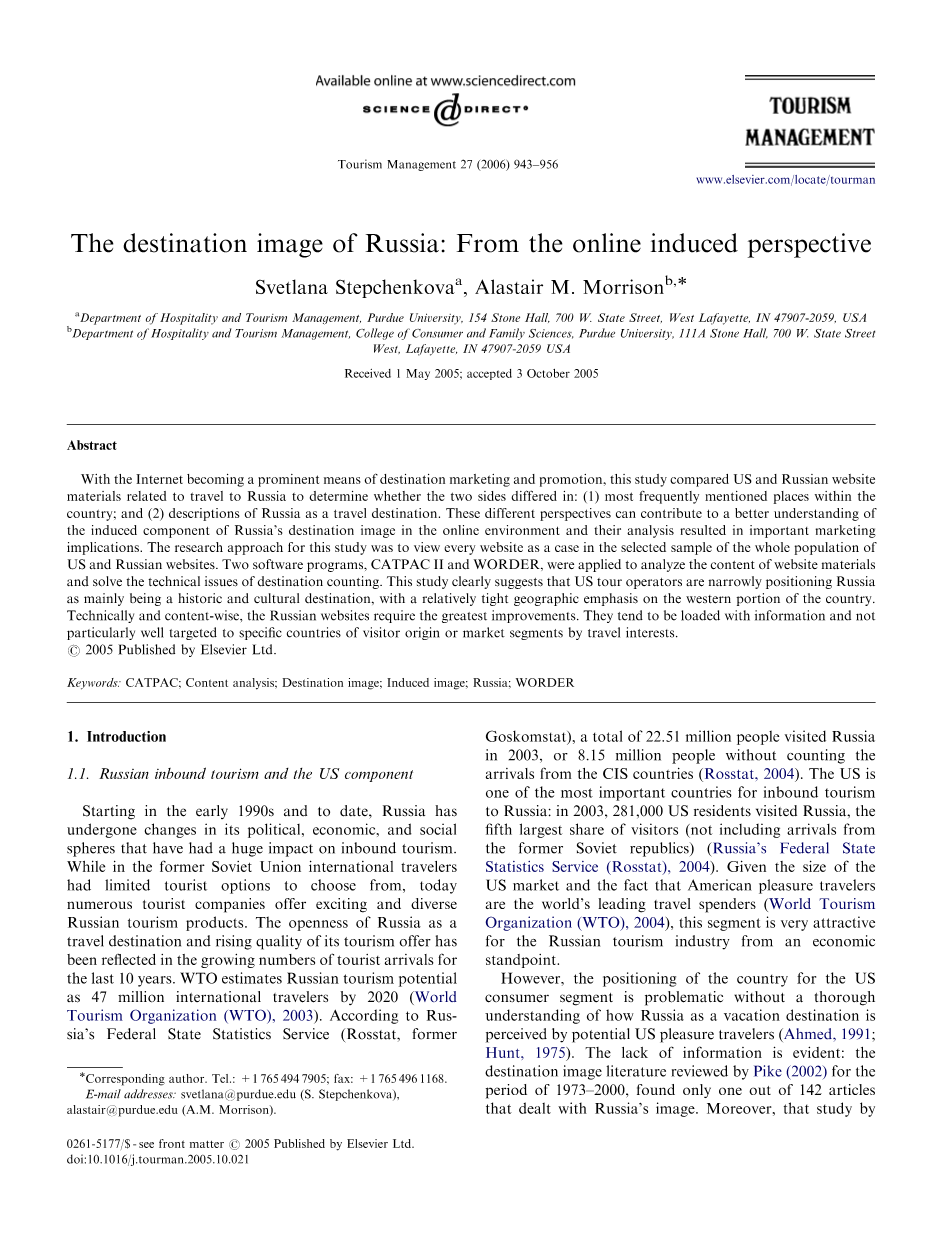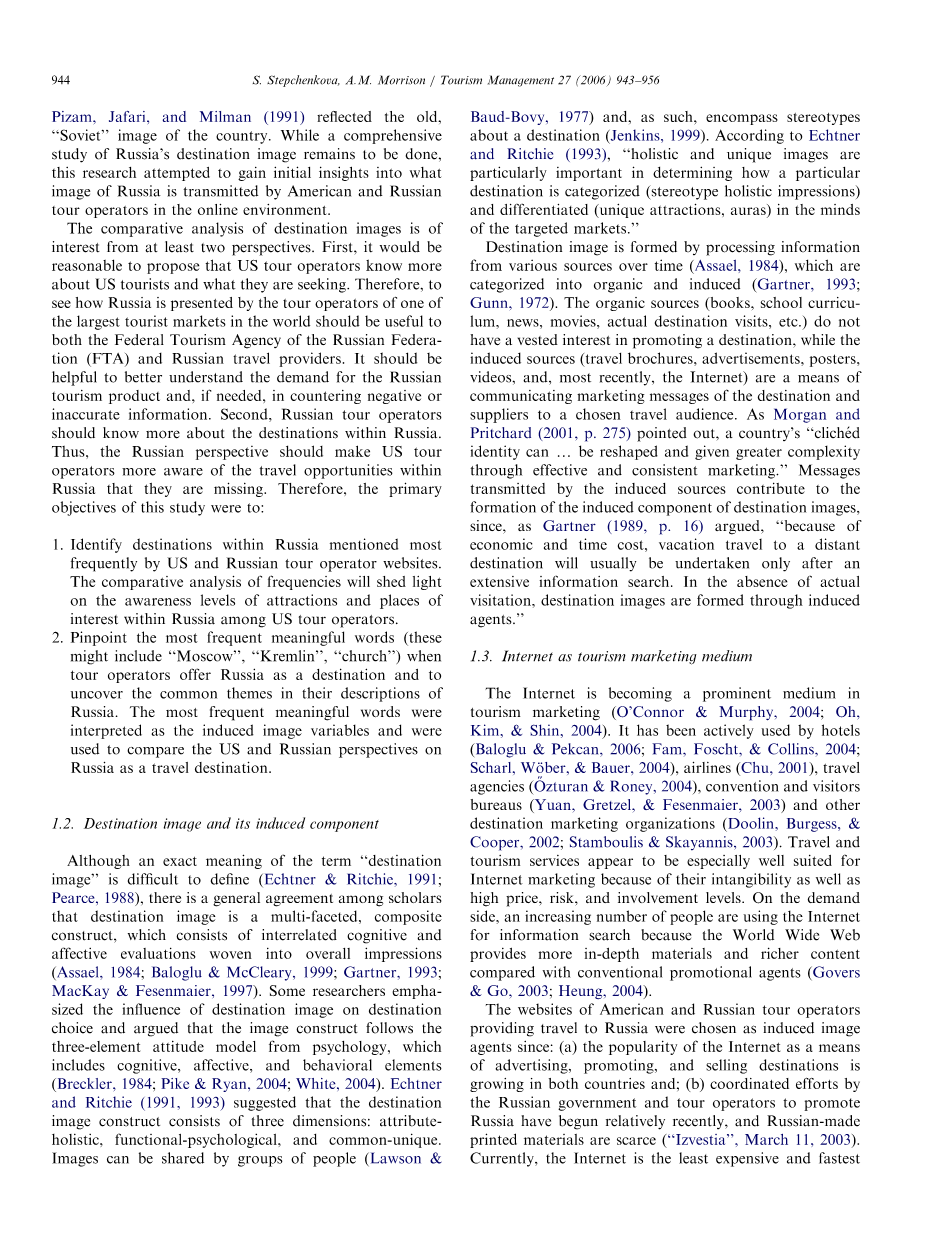钱江源国家公园体制试点区旅游形象及感知差异研究外文翻译资料
2023-03-13 11:15:10
钱江源国家公园体制试点区旅游形象及感知差异研究
摘要:随着web2.0时代的到来,越来越多的旅游者行前通过网络获取信息,游后借助自媒体分享旅游体验,相关研究开始将微博、旅游网站等用户生成的数据作为分析旅游目的地形象的数据源,采用非结构方法即内容分析方法研究旅游者对目的地的感知形象。Choi等运用CATPACⅡ软件,通过对澳门官方旅游网站、旅行社网站等文本信息进行内容分析,探讨了澳门的旅游形象。Cora也进行了类似的研究,基于在线评论,对澳门旅游形象的演变进行了分析。Stepchenkova通过收集美俄两国旅游网站信息,利用内容分析法,对比研究了两国游客对俄罗斯国家旅游形象的不同感知。
关键词:旅游形象;用户贡献内容;文本挖掘;澳门;俄罗斯
引用文献一:
基于在线评论文本挖掘的旅游目的地形象演变研究
—以澳门为例
原文作者 Cora Un In Wong, Shanshan Qi 单位Institute for Tourism Studies, Macau
本文使用特定的文本挖掘技术,调查了2005年至2013年间TripAdvisor对澳门评论内容的演变。这一时期在TripAdvisor和澳门的历史上都具有特别重要的意义。在此期间,TripAdvisor的澳门评论数量激增,几乎从零开始,而澳门作为旅游目的地,从一个古怪的脚注到香港变成了“东方的拉斯维加斯”。在此期间,大量新的赌博和非赌博景点向游客开放,游客数量大幅增加。
本文主要依赖于在用户生成旅游数据的主要媒介—名称为TripAdvisor的澳门的文本表示。它被公认为是一个国际在线信息交流平台,来自世界各地的游客在这里就与旅游业相关的特定主题发表评论和接受评论(Filieriamp;McLeay,2013)。
本文采用的方法是新颖的,它通过文本挖掘存储在流行旅游社交平台上的在线评论,描述了在相当长的一段时间内不断变化的目的地的演变。虽然对这些来源的文本挖掘已被用于调查一些特定时间点的目的地(包括澳门)形象,但据作者所知,它从未被用于跟踪目的地形象的演变。TripAdvisor这样的网站仔细记录了所有过去的评论,而且这些评论都是数字形式的,这为文本挖掘工具的应用提供了便利。可用文本挖掘程序的不断增加也有利于此类练习。直到现在,TripAdvisor(诞生于2000年)等网站上的目的地评论的多年存储库和文本挖掘工具库才可用。人们自然会期望像现在这样的研究在未来会变得更加普遍。例如,就澳门本身而言,在中国社交媒体上使用Man-darin评论重复这一做法,并了解中国游客的看法是否与国际游客的看法不同,这将是一个有趣的问题。更一般地说,未来研究的自然途径是将该方法应用于其他目的地,试验其他文本挖掘工具,而不是此处使用的工具,并调查目的地图像的特定方面,而不是其整体图像。
外文文献出处:Cora Un In Wong, Shanshan Qi ,Tracking the evolution of a destinations image by text-mining online reviews - the case of Macau [J].Tourism Management Perspectives, 2017, 23: 19-29.
附外文文献原文
Tracking the evolution of a destinations image by text-mining online reviews - the case of Macau
Keywords: Destination image;User-generated content;Text-mining;Macau
This article uses specific text-mining technique to investigate the evo- lution of the content of TripAdvisor reviews about Macau between 2005 and 2013. The period is particularly significant in the history of both TripAdvisor and Macau. In the course of this period, the number of Macau reviews on TripAdvisor exploded, starting from almost nothing, and Macau as a tourist destination metamorphosed itself from a quaint footnote to Hong Kong into the lsquo;Las Vegas of the Eastrsquo;. A significant num- ber of new gambling and non-gambling attractions became available to the visitors during this period, which saw an enormous increase in their number.
This paper thus relies mostly on the textual representations of Macau found in a leading medium for user-generated data about tourism, namely TripAdvisor. It is well-recognized as an international online information exchange platform where tourists from all over the world give and re- ceive comments on a particular subject related to travel and tourism (Filieri amp; McLeay, 2013).
The approach used in this paper is novel in that it characterizes the evolution of a changing destination over a significant number of years through text-mining the online reviews stored on a popular tourism social platform. While text-mining of such sources has been used to investigate a number of destinations - including Macaus - image at a particular point in time, it has, as far as the authors know, never been used to trace the evolution of a destinations image. The facts that a website like TripAdvisor meticulously keeps a record of all past reviews and that those are in digital form make it convenient for the application of text-mining tools. The increasing inventory of available text-mining programs is also a development favorable to such exercises. It is only now that both a multiple-year repository of reviews of destinations on sites such as TripAdvisor (born in 2000), and an arsenal of text-mining tools are available. One would naturally expect that studies such as the present one would become more common in the future. As regards Macau itself, it would for example be of interest to repeat the exercise using Man- darin reviews on Chinese social media and find out whether Chinese tourists perceptions are different from the ones of international tourists. More generally, natural avenues for future research would be to apply the approach to other destinations, experiment with other text-mining tools than the ones used here, and investigate spe- cial aspects of a destinations image rather than its image as a whole.
引用文献二:
俄罗斯的目的地形象:从网络诱导的角度
原文作者 Stepchenkova Svetlana;Morrison Alastair M.
单位Department of Hospitality and Tourism Management, Purdue University, 154 Stone Hall, 700 W. State Street, West Lafayette, IN 47907-2059, USA; Department of Hospitality and Tourism Management, College of Consumer and Family Sciences, Purdue University, 111A Stone Hall, 700 W. State Street West, Lafayette, IN 47907-2059 USA
随着互联网成为目的地营销和推广的重要手段,本研究比较了美国和俄罗斯网站上与前往俄罗斯旅游相关的材料,以确定双方在以下方面是否存在差异:(1)国内最常提到的地方;(2)将俄罗斯描述为旅游目的地。这些不同的视角有助于更好地理解网络环境中俄罗斯目的地形象的诱导成分,它们的分析产生了重要的营销影响。本研究的研究方法是将每个网站视为一个案例,在美国和俄罗斯网站的全部人口中选择样本。应用CATPAC II和WORDER软件对网站资料内容进行分析,解决目的地统计的技术问题。这项研究清楚地表明,美国旅游运营商狭隘地将俄罗斯定位为一个主要是历史和文化目的地的国家,在地理上相对紧凑地强调该国的西部地区。在技术和内容方面,俄罗斯网站需要最大的改进。它们往往承载着大量的信息,而不是特别针对特定的游客来源国或旅游兴趣细分市场。
外文文献出处:Stepchenkova S, Morrison A M. The destination
剩余内容已隐藏,支付完成后下载完整资料


英语原文共 25 页,剩余内容已隐藏,支付完成后下载完整资料
资料编号:[597019],资料为PDF文档或Word文档,PDF文档可免费转换为Word




